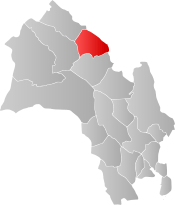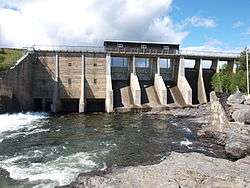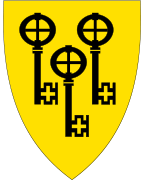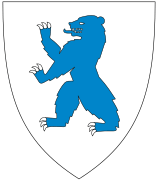Gol, Norway
| Gol kommune | |||
|---|---|---|---|
| Municipality | |||
|
| |||
| |||
 Gol within Buskerud | |||
| Coordinates: 60°45′1″N 8°59′5″E / 60.75028°N 8.98472°ECoordinates: 60°45′1″N 8°59′5″E / 60.75028°N 8.98472°E | |||
| Country | Norway | ||
| County | Buskerud | ||
| District | Hallingdal | ||
| Administrative centre | Gol | ||
| Government | |||
| • Mayor (2003) | Jan-Halvard Brekko (Ap) | ||
| Area | |||
| • Total | 533 km2 (206 sq mi) | ||
| • Land | 514 km2 (198 sq mi) | ||
| Area rank | #200 in Norway | ||
| Population (2004) | |||
| • Total | 4,372 | ||
| • Rank | #218 in Norway | ||
| • Density | 8/km2 (20/sq mi) | ||
| • Change (10 years) | 1.4% | ||
| Demonym(s) | Goling[1] | ||
| Time zone | UTC+01:00 (CET) | ||
| • Summer (DST) | UTC+02:00 (CEST) | ||
| ISO 3166 code | NO-0617 | ||
| Official language form | Nynorsk | ||
| Website |
www | ||
![]()
General information
Name
The Old Norse form of the name was Gǫrð. This is probably an old river name (for the lower part of Hemsil river). The name of the river maybe derived from the word garðr m 'fence; border' - and the meaning is then 'the border river'.
Coat-of-arms
The coat-of-arms is from modern times. They were granted on 13 September 1985. The arms are gold with three black keys in the center. The keys are derived from the key for Gol stave church.[3][4]
Transport
The Bergen Line from Bergen to Oslo runs through Gol Station which opened in 1907. Gol is connected to Norwegian National Road 7, 50 and 52 as well as Norwegian county road 51. There are daily bus connections to Gjøvik and Lillehammer.[5]
| Ancestry | Number |
|---|---|
| 131 | |
| 77 | |
| 56 | |
| 46 | |
| 30 |
Gol Church
Gol Church (Gol kirke) was constructed during 1882 based upon a design by architect Henrik Nissen. The church is characterized by neo-Gothic style with gables and small towers with crosses. It was built of wood and has 500 seats.[7]
The mediaeval Gol stave church (built ca. 1216) was due for demolition after the construction of the larger and new church. Gol stave church was saved from destruction by the Society for the Preservation of Ancient Norwegian Monuments (Fortidsminneforeningen), which bought the materials with the intention of re-erecting the church elsewhere. Financial problems were solved when King Oscar II decided to pay for its relocation and restoration as the central building of his private open-air museum near Oslo.[8]
The restoration was overseen by architect Waldemar Hansteen. It was completed in 1885. In 1907, the royal museum was merged with the Norsk Folkemuseum, which now manages the stave church, still nominally belonging to the reigning monarch.[9]

Attractions
- Gordarike Familiepark is a theme park located in downtown Gol. The theme and environment are built to reflect the Viking Era and Middle Ages. A modern replica of Gol stave church has been built as a tourist attraction at the park. The replica was built in the 1980s and consecrated in 1994.[10]
- Gol Bygdetun is an open-air museum located in the village of Gol. It was built around the old Skaga farm. It is dedicated to the cultural history of Gol, and contains farm buildings of nearly all types. Barns, lofts and wooden stables are all featured together with a millhouse, a school house and a log cabin. The oldest building dates back to 17th century. Gol Bygdetun is a subsidiary of Hallingdal Museum which operating in association with Buskerudmuseet.[11][12]
Notable residents
- Bjørn Tolleivson Frøysåk (1634 in Gol – 1709) was a Norwegian farmer and merchant. He was born into one of the major farming families in Hallingdal. He is particularly known for a painted epitaph from 1699, showing him and his large family. The epitaph, originally in Gol Stave Church, was relocated to the Norwegian Museum of Cultural History in 1906.
- Johan Willoch Erichsen (1842 – 1916 in Gol) was a Norwegian bishop and theologian in the Church of Norway. He was Bishop of the Diocese of Bjørgvin from 1899 until shortly before his death in Gol in 1916.
- Hans Johan Jensen (1882 – ?) was a Norwegian politician for the Labour Party. In 1909 he settled in Gol as a farmer and carpenter and was first elected to Gol municipal council in 1913, and was re-elected nine times. In 1928 he was also elected to the Norwegian Parliament for his constituency Buskerud.
- Sigrun Eng (born 1951 in Sør-Fron) is a Norwegian politician who belongs to the Labour Party. She was elected to the Norwegian Parliament from Buskerud in 1993, and has been re-elected on three occasions. She was a member of Gol municipal council from 1983 to 1991
- Pål Golberg (born 1990 in Gol) is a Norwegian cross country skier. His best World Cup finish so far is first in an individual sprint event in Lahti, and in an individual-start 15k classic in Oslo.
- Li Simon (born 1927 in Copenhagen/Denmark, died in Gol 2017) is known for her rediscovery of print on fur blankets in the early 1950s. She and her husbond Vult Simon collected old print blocks from all over Norway and carefully copied them by hand in new wood. This tradition disappeared approx. 1900. The symbols where meant to affect on people and give them strength when they slept under these furs at night. After having great success for many years with this art of work, she started giving courses in this handicraft in 2000. In 2000 she published Skinnfellboka as the first in Norway to document this subject. Skinnfellboka was released again in 2010. Currently print on fur is a very popular handicraft throughout Norway.
Sister cities
The following cities are twinned with Gol:



Gallery
 Tisleifjorden Dam
Tisleifjorden Dam Gol Train Station
Gol Train Station- Hemsil II Kraftverk
- Gol Police Station
- Elektroservice Hallingdal
References
- ↑ "Navn på steder og personer: Innbyggjarnamn" (in Norwegian). Språkrådet. Retrieved 2015-12-01.
- ↑ Geir Thorsnæs. "Gol". Store norske leksikon. Retrieved October 1, 2017.
- ↑ Norske Kommunevåpen (1990). "Nye kommunevåbener i Norden". Retrieved 2009-01-07.
- ↑ "Kommunevåpenet" (in Norwegian). Gol kommune. Archived from the original on 2009-02-18. Retrieved 2009-01-07.
- ↑ "Gol in Hallingdal". Innovation Norway. Retrieved October 1, 2017.
- ↑ "Immigrants and Norwegian-born to immigrant parents, by immigration category, country background and percentages of the population". ssb.no. Archived from the original on 2 July 2015. Retrieved 29 July 2017.
- ↑ Sigrid Marie Christie, Håkon Christie. "Gol kirke". Norges Kirker. Retrieved October 1, 2017.
- ↑ Lars Roede. "Foreningen til norske Fortidsminnesmerkers Bevaring". Store norske leksikon. Retrieved October 1, 2017.
- ↑ Bjørn Cappelen. "Waldemar Hansteen". Store norske leksikon. Retrieved October 1, 2017.
- ↑ "Gol Stave Church at Gordarike Familiepark, Gol". Innovation Norway. Retrieved October 1, 2017.
- ↑ Gol Bygdemuseum (Hallingdal Museum)
- ↑ "Buskerudmuseet". Stiftelsen Buskerudmuseet. Retrieved October 1, 2017.
External links
| Wikimedia Commons has media related to Gol. |
| Look up Gol in Wiktionary, the free dictionary. |
- Municipal fact sheet from Statistics Norway



